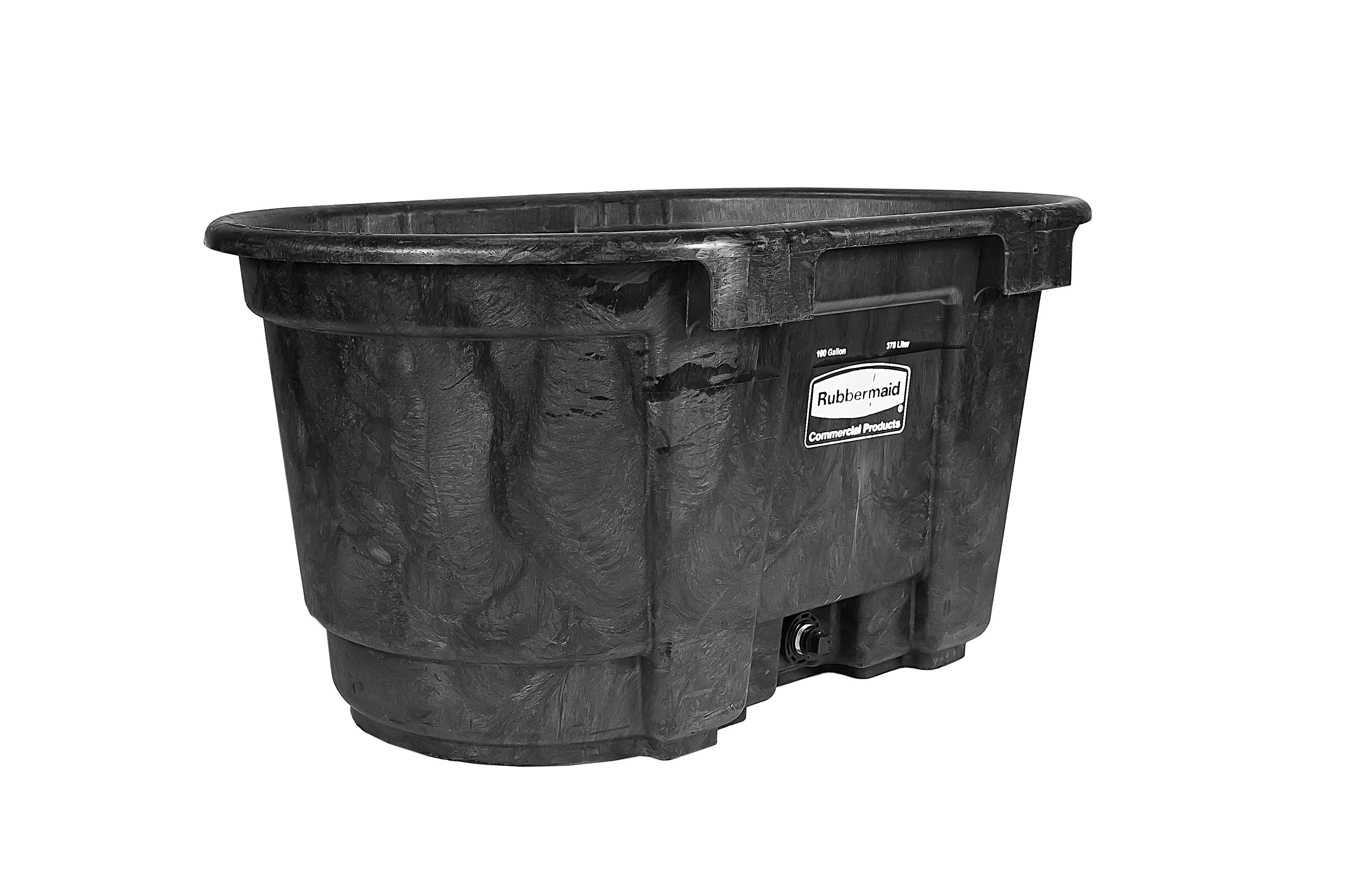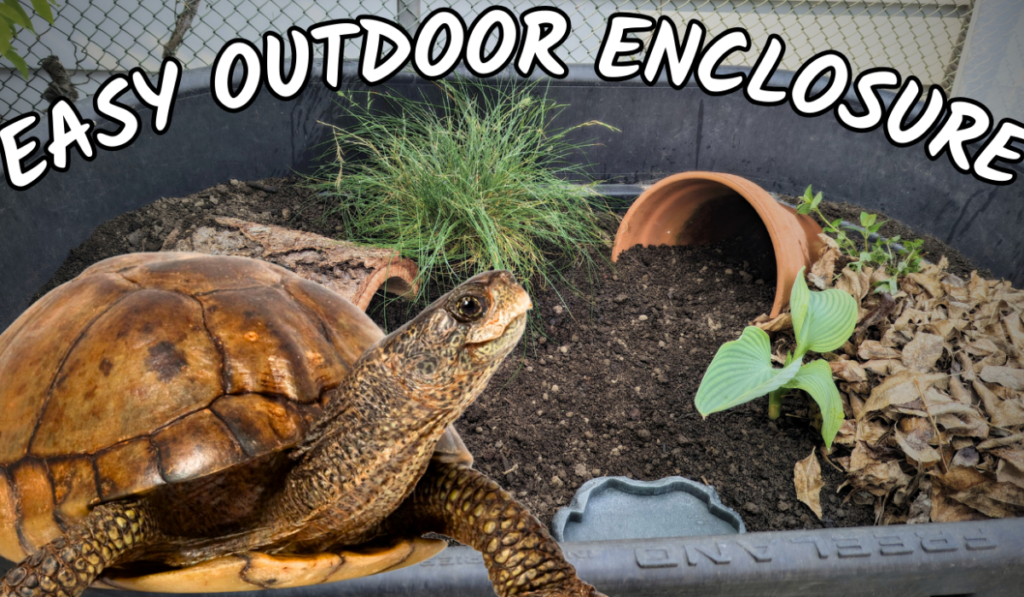In this DIY Outdoor Tortoise Enclosure Pen Build & Setup I will show you exactly how to build a DIY outdoor turtle enclosure from start to finish. There are a lot of different types of turtle habitats, but I show you my method of using a large water trough and converting it to a suitable habitat for my box turtle. While this post is all about my three-toed box turtle, April, the habitat tutorial will work with any tortoise species!
Depending on where you live, this outdoor pen could be a year-round home for your pet, a home for part of the year, or just a safe place for your turtle to enjoy time outside. No matter how you keep your pet, spending times outdoors in unfiltered sunlight is very beneficial to pet tortoises that are kept in captivity. Since I live in Wisconsin, and winter temps here regularly fall below 10 degrees, this outdoor habitat is only a home for my box turtle for about half the year. The following advice applies primarily to box turtles or small tortoise species such as Russian Tortoises, but with a few modifications you can make this outdoor habitat fit any tortoise species.
Enclosure Type and Size
It is fairly straightforward to build your own box turtle enclosure out of two by fours, or fencing. Typically a large, enclosed, square space is a great layout for your pets. And making your own custom habitat can be as easy as screwing some wood together. Most tortoise owners prefer an enclosure with solid sides, instead of a wire fence. This is because box turtles and tortoises can be surprisingly good climbers, and may use the wire or chain link to climb to their escape. The height of your turtle pen should be at least twice the length of your turtle, but slightly taller is always better to prevent escapes.
In the wild, most tortoise and box turtle species roam over large distances throughout their lives, and will utilize any/all space you give them. Most experts agree if you have multiple turtles, or if this is a full time home for your animal, a good enclosure size starts at 4 feetx8feet, and even larger for bigger species. If your tortoise is spending more time outside, if you have multiple tortoises, or a large tortoise species, you may want to increase the enclosure size.
As far as where to build your tortoise habitat – plan on placing your enclosure in a sunny location with good morning and early afternoon sunlight. Tortoises benefit greatly from basking in natural, unfiltered light but they can still overheat if daytime temps get too warm. Be sure your pet has plenty of access to both sunshine and shaded areas, especially if your home gets strong midday sunlight.
Tortoises are also great diggers, so if you are housing your turtle on grass make sure to sink the sides of the cage down into the ground, 8-14+ inches.
Below are various box turtle and tortoise habitats that people have built themselves, so be creative with this step!

Since I only have one box turtle, and this outdoor pen is not her fulltime home, I decided to use an extra large rubber feeding trough from Farm and Fleet for her outdoor setup. This trough has a spigot for drainage, and can be setup anywhere in my backyard. It limits escapes because it is made out of thick plastic/rubber and my turtle cannot dig out.

Keeping Your Turtle Safe
If you are keeping your turtle outside full-time, I highly recommend building a covering or lid for your enclosure. You can easily make your own lid by making a wooden frame with wire mesh. You can also add handles or locks to your lid to add additional security for when you are not monitoring your pet.
A cover will not only keep your turtle from escaping, it will also prevent any unwanted critters from getting into your enclosure. Raccoons, opossums, birds of prey, outdoor pets, and other animals can all be a threat to your captive turtle or tortoise. To reduce the risk of pests and unwanted critters, clean up any uneaten tortoise food daily and do not leave food out overnight.
What to Put Inside Your Tortoise Habitat
- Substrate: Turtles and tortoises often burrow to thermoregulate and get away from the hot midday sun. If you are using a rubber trough for your turtle enclosure, or planning on building their pen on top of concrete, a thick layer of substrate is a must for any tortoise species. Use a mix of topsoil, mulch, eco earth and play sand to create a deep layer of soil for your pet to dig in. I like to provide several feet of digging space for my box turtle, and she is regularly several inches deep beneath the earth. Please note: If you are building your pen on top of grass, lawn or your backyard, your turtle will eventually dig through your grass to create burrows. To encourage their digging in a specific spot, dig up an area of lawn and mix the soil with leaf litter, grass clippings, top soil or shredded bark to make a loose mix that your pet can easily burrow into.
- Hides: Wooden hides, branches, half logs, reptile décor and even terracotta pots can make a great hide for your tortoise. If you have a larger species, consider building a hide by stacking cinderblocks into a large shelter. Have at least one hide per individual, but more is always better! Small sticks, logs, rocks and more are all great and give your per something to explore. Here’s a tip: Box turtles LOVE leaf piles. Pick up leaves from your yard and create a leaf pile in your turtle pen. Your box turtle will thank you for it 🙂
- Plants: You can use live plants in your tortoise habitat. Research plants and grasses native to your area and select those that are non-toxic for turtles in case your pet decides to snack on some. You can even plant edible herbs, berries, greens, or clover to save money on feeding your pets.
- Water: Providing access to water is essential for your turtle’s health. A shallow dish of water can be sunk into the ground to prevent it from tipping. The water dish must be large enough for turtles to completely sit inside, but easy to get in and out of. The water dish should be cleaned and re-filled regularly.
I hope this article was helpful in giving your turtle or tortoise an outdoor home! Even a few hours of outdoor activity per week is very beneficial to tortoises kept in captivity. If you can’t build an outdoor pen from scratch, get creative with how you give your pet time outdoors! Use a stock tank or feeding trough like I did, or fill a kid’s wading pool with some substrate to give your turtle some natural sunshine. Your pet will be healthier and happier for it!
Please let me know if you have any questions! I always try to read and reply to any comments.
Looking for more information on Exotic Pet Care? Browse our archive of articles!



